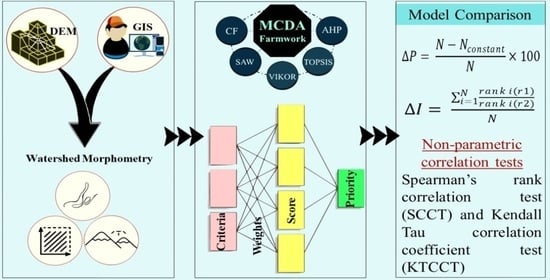Comparative Analysis of MCDA Techniques for Identifying Erosion-Prone Areas in the Burhanpur Watershed in Central India for the Purposes of Sustainable Watershed Management
Abstract
1. Introduction
2. Materials and Methods
2.1. Study Area and Data
2.2. Sub-Watershed Mapping and Morphometric Analysis
2.3. MCDA-Based Sub-Watersheds Prioritization
2.3.1. Criteria Weightage for MCDA
2.3.2. Analytical Hierarchy Process Technique
2.3.3. Technique for Order of Preference by Similarity to Ideal Solution (TOPSIS)
2.3.4. VIseKriterijumska Optimizacija I Kompromisno Resenje Technique (VIKOR)
2.3.5. Simple Additive Weighting (SAW)
2.3.6. Compound Factor (CF) Technique
2.4. Model Synthesis and Final Priority Ranking
2.5. MCDA Model Comparison
3. Results
3.1. Sub-Watershed Mapping and Morphometric Analysis
3.2. Criterion Weightage for MCDA
3.3. Sub-Watershed Prioritization Using Different MCDA Techniques
3.3.1. Watershed Prioritization Using AHP
3.3.2. Watershed Prioritization Using TOPSIS
3.3.3. Watershed Prioritization Using VIKOR
3.3.4. Watershed Prioritization Using SAW
3.3.5. Watershed Prioritization Using Compound Factor (CF)
3.4. MCDA Model Comparison
4. Discussion
4.1. Morphometric Analysis
4.2. Prioritization by MCDA Models
4.3. Comparative Analysis
4.4. Application and Role of Prioritization in Soil Conservation Approach
- Targeted approach: Prioritization directs resources to high-risk and vulnerable areas, maximizing the impact of soil conservation measures for effective outcomes.
- Resource optimization: Prioritization optimizes the use of limited resources (time, manpower, and funding), ensuring that they are allocated to areas where they can have the greatest impact in implementing soil conservation measures.
- Prevention of further degradation: Prioritization aids in timely intervention and prevention of soil degradation and erosion in high-priority areas, resulting in stabilized soils, reduced erosion rates, and preservation of valuable topsoil and nutrients.
- Long-term sustainability: By addressing the most vulnerable areas first, the overall health and productivity of the watershed is enhanced. This supports sustainable land-use practices, preserves ecosystem integrity, secures fertile soils, and promotes long-term sustainability for future generations.
- Stakeholder engagement and support: Prioritization facilitates stakeholder (communities, farmers, landowners, and relevant authorities) engagement and collaboration. This can enhance the acceptance of, participation in, and support for soil conservation measures, leading to their successful implementation and long-term maintenance.
4.5. Challenges with MCDA Techniques
5. Conclusions
- Morphometric parameters: The study emphasized the higher significance of relief parameters compared to linear and areal parameters in prioritization, based on their relative importance in the erosion process.
- MCDA techniques: The study successfully prioritized sub-watersheds using five MCDA techniques (AHP, TOPSIS, VIKOR, SAW, and CF) and found these techniques suitable for providing valuable insights into the relative priority of sub-watersheds in terms of their erosion susceptibility.
- Sub-watershed prioritization: The results indicated that the amount of area in each of the priority classes varied across the models. The area classed as very high-priority was recorded in the range of 8.34% to 30.15%. Further, the area classed as high, moderate, and low priority was found to be in the range of 23.38–52.05%, 7.47–49.99%, and 10.33–18.28%, respectively.
- Comparative Performance: The performance of the models was compared using four indices (percentage of changes, intensity of changes, the Spearman rank correlation coefficient test, and the Kendall tau correlation coefficient test), and it was found that the SAW, TOPSIS, VIKOR, and AHP models had higher correlation (0.84–0.99 at p = 0.01) and lesser percentage change and change intensity than the CF technique. Overall, the SAW, TOPSIS, VIKOR, and AHP models performed better than the CF model, with higher confidence.
Author Contributions
Funding
Data Availability Statement
Conflicts of Interest
Appendix A
Appendix A.1. Analytical Hierarchy Process Technique
- I.
- Generation of decision matrix (D) of dimension m × n with respect to the alternatives and the criteria, respectively:The decision matrix is a matrix containing all the criteria values relative to all the alternatives and is used in several MCDA techniques to evaluate and rank the alternatives. Where i = 1, 2,…, m (number of alternatives), j = 1, 2,…, n (number of criteria).
- II.
- Normalizing the decision matrix (N)where is the element of the normalized decision matrix for the i-th alternative in the j-th criterion.
- III.
- IV.
- Calculating score (initial priority value) for alternatives [72]:These scores are the initial priority values obtained using AHP. A higher value is of higher priority in the case of AHP.
Appendix A.2. Technique for Order of Preference by Similarity to Ideal Solution (TOPSIS)
- I.
- Generation of decision matrix (D) as described in Equation (A1).
- II.
- Normalizing the decision matrix (N),where is the element of normalized decision matrix for the i-th alternative in the j-th criterion.
- III.
- IV.
- V.
- Estimation of direct distance to and :
- VI.
- Extraction of closeness index (CI) as initial priority values:These CI values are the initial priority values obtained using TOPSIS. A higher CI value is of higher priority in the case of TOPSIS.
Appendix A.3. VIseKriterijumska Optimizacija I Kompromisno Resenje Technique (VIKOR) Technique
- I.
- Generation of decision matrix (D) as described in Equation (A1).
- II.
- Normalizing the decision matrix (N), where is the element of matrixand is the element of normalized decision matrix for the i-th alternative in the j-th criterion.
- III.
- IV.
- Retrieving the best and the worst ) value:
- V.
- Calculating boundary values utility index () and regret index ():
- VI.
- Calculating the final measure () [75]:where and is the balance weight between and . Here, .The option with minimum values for all three parameters (S, R, and Q) is the best option.These values are the initial priority values obtained using the VIKOR technique. A lower value is of higher priority in the case of VIKOR.
Appendix A.4. Simple Additive Weighting (SAW)
- I.
- Generation of decision matrix (D) as described in Equation (A1).
- II.
- Determination of values as or ; if the j-th criterion is directly proportional (DP) or indirectly proportional (IP) with the goal, respectively.
- III.
- Normalizing the decision matrix (N), where is the element of matrix,orwhere is element of normalized decision matrix for i-th alternative in j-th criterion.
- IV.
- V.
- Calculating score (initial priority value) for alternatives [72]:These scores are the initial priority values obtained using SAW. A higher value is of higher priority in the case of SAW.
Appendix A.5. Compound Factor (CF) Technique
- I.
- Generation of decision matrix (D) as described in Equation (A1).
- II.
- Generation of rating matrix:If the criterion is directly proportional to the goal (erosion sensitivity), ascending ordering must be completed, i.e., the alternative (sub-watershed) having the highest value for a criterion must be rated as first rank, the sub-watershed with the second-highest value must be rated as second rank, and so on.If the criterion is inversely proportional to the goal (erosion sensitivity), descending ordering must be completed, i.e., the alternative (sub-watershed) having the lowest value for a criterion must be rated first, the sub-watershed with the second-lowest value must be rated second, and so on.
- III.
- Calculating the compound values:where is the compound factor value (initial priority value) for the i-th alternative, is the rating of alternatives, and n is the number of criteria. A lower value is of higher priority in the case of CF.
References
- Machiwal, D.; Patel, A.; Kumar, S.; Naorem, A. Status and Challenges of Monitoring Soil Erosion in Croplands of Arid Regions. In Soil Health and Environmental Sustainability: Application of Geospatial Technology; Shit, P.K., Adhikary, P.P., Bhunia, G.S., Sengupta, D., Eds.; Environmental Science and Engineering; Springer International Publishing: Cham, Switzerland, 2022; pp. 163–192. ISBN 978-3-031-09270-1. [Google Scholar]
- Patel, A.; Kushwaha, N.L.; Rajput, J.; Gautam, P.V. Advances in Micro-Irrigation Practices for Improving Water Use Efficiency in Dryland Agriculture. In Enhancing Resilience of Dryland Agriculture under Changing Climate: Interdisciplinary and Convergence Approaches; Naorem, A., Machiwal, D., Eds.; Springer Nature: Singapore, 2023; pp. 157–176. ISBN 978-981-19915-9-2. [Google Scholar]
- Manivannan, S.; Thilagam, V.K.; Khola, O.P.S. Soil and Water Conservation in India: Strategies and Research Challenges. J. Soil Water Conserv. 2017, 16, 312. [Google Scholar] [CrossRef]
- Patel, A.; Kethavath, A.; Kumar, M.; Rao, K.; Srinivasrao, C. Sustainable Land and Water Management for Reducing Soil Erosion in Tropical India. In Agricultural Research, Technology and Policy: Innovations and Advances; Srinivasrao, C., Balakrishnan, M., Krishnan, P., Sumanthkumar, V., Eds.; National Academy of Agricultural Research Management: Hyderabad, India, 2021; pp. 333–347. ISBN 978-93-5526-149-6. [Google Scholar]
- Meshram, S.G.; Alvandi, E.; Meshram, C.; Kahya, E.; Fadhil Al-Quraishi, A.M. Application of SAW and TOPSIS in Prioritizing Watersheds. Water Resour. Manag. 2020, 34, 715–732. [Google Scholar] [CrossRef]
- Weldu Woldemariam, G.; Edo Harka, A. Effect of Land Use and Land Cover Change on Soil Erosion in Erer Sub-Basin, Northeast Wabi Shebelle Basin, Ethiopia. Land 2020, 9, 111. [Google Scholar] [CrossRef]
- Patel, A.; Kethavath, A.; Kushwaha, N.L.; Naorem, A.; Jagadale, M.; Sheetal, K.R.; Renjith, P.S. Review of Artificial Intelligence and Internet of Things Technologies in Land and Water Management Research during 1991–2021: A Bibliometric Analysis. Eng. Appl. Artif. Intell. 2023, 123, 106335. [Google Scholar] [CrossRef]
- Arabameri, A.; Tiefenbacher, J.P.; Blaschke, T.; Pradhan, B.; Tien Bui, D. Morphometric Analysis for Soil Erosion Susceptibility Mapping Using Novel GIS-Based Ensemble Model. Remote Sens. 2020, 12, 874. [Google Scholar] [CrossRef]
- Alexakis, D.D.; Hadjimitsis, D.G.; Agapiou, A. Integrated Use of Remote Sensing, GIS and Precipitation Data for the Assessment of Soil Erosion Rate in the Catchment Area of “Yialias” in Cyprus. Atmos. Res. 2013, 131, 108–124. [Google Scholar] [CrossRef]
- Chopra, R.; Dhiman, R.D.; Sharma, P.K. Morphometric Analysis of Sub-Watersheds in Gurdaspur District, Punjab Using Remote Sensing and GIS Techniques. J. Indian Soc. Remote Sens. 2005, 33, 531–539. [Google Scholar] [CrossRef]
- Wang, G.; Mang, S.; Cai, H.; Liu, S.; Zhang, Z.; Wang, L.; Innes, J.L. Integrated Watershed Management: Evolution, Development and Emerging Trends. J. For. Res. 2016, 27, 967–994. [Google Scholar] [CrossRef]
- Wani, S.P.; Pathak, P.; Sreedevi, T.K.; Singh, H.P.; Singh, P. Efficient Management of Rainwater for Increased Crop Productivity and Groundwater Recharge in Asia. In Water Productivity in Agriculture: Limits and Opportunities for Improvement; Kijne, J.W., Barker, R., Molden, D.J., Eds.; CABI Publishing: Wallingford, UK, 2003; pp. 199–215. [Google Scholar]
- Rezaei-Moghaddam, K.; Fatemi, M. The Network Analysis of Organizations in Watershed Management toward Sustainability in Northern Iran. Front. Environ. Sci. 2023, 11, 1078007. [Google Scholar] [CrossRef]
- Malik, M.I.; Bhat, M.S.; Kuchay, N.A. Watershed Based Drainage Morphometric Analysis of Lidder Catchment in Kashmir Valley Using Geographical Information System. Recent Res. Sci. Technol. 2011, 3, 118–126. [Google Scholar]
- Paul, I.I.; Bayode, E.N. Watershed Characteristics and Their Implication for Hydrologic Response in the Upper Sokoto Basin, Nigeria. J. Geogr. Geol. 2012, 4, 147. [Google Scholar] [CrossRef][Green Version]
- Rodrigo Comino, J.; Iserloh, T.; Lassu, T.; Cerdà, A.; Keestra, S.D.; Prosdocimi, M.; Brings, C.; Marzen, M.; Ramos, M.C.; Senciales, J.M.; et al. Quantitative Comparison of Initial Soil Erosion Processes and Runoff Generation in Spanish and German Vineyards. Sci. Total Environ. 2016, 565, 1165–1174. [Google Scholar] [CrossRef] [PubMed]
- Sarkar, P.; Kumar, P.; Vishwakarma, D.K.; Ashok, A.; Elbeltagi, A.; Gupta, S.; Kuriqi, A. Watershed Prioritization Using Morphometric Analysis by MCDM Approaches. Ecol. Inform. 2022, 70, 101763. [Google Scholar] [CrossRef]
- Strahler, A. Quantitative Geomorphology of Drainage Basins and Channel Networks. In Handbook of Applied Hydrology; Chow, V.T., Ed.; McGraw Hill: New York, NY, USA, 1964; pp. 439–476. [Google Scholar]
- Faisal, R.M. GIS and MCDMA Prioritization Based Modeling for Sub-Watershed in Bastora River Basin. Geocarto Int. 2021, 37, 6826–6847. [Google Scholar] [CrossRef]
- Yadav, S.K.; Dubey, A.; Szilard, S.; Singh, S.K. Prioritisation of Sub-Watersheds Based on Earth Observation Data of Agricultural Dominated Northern River Basin of India. Geocarto Int. 2018, 33, 339–356. [Google Scholar] [CrossRef]
- Ahmed, R.; Sajjad, H.; Husain, I. Morphometric Parameters-Based Prioritization of Sub-Watersheds Using Fuzzy Analytical Hierarchy Process: A Case Study of Lower Barpani Watershed, India. Nat. Resour. Res. 2018, 27, 67–75. [Google Scholar] [CrossRef]
- Bogale, A. Morphometric Analysis of a Drainage Basin Using Geographical Information System in Gilgel Abay Watershed, Lake Tana Basin, Upper Blue Nile Basin, Ethiopia. Appl. Water Sci. 2021, 11, 122. [Google Scholar] [CrossRef]
- Nautiyal, M.D. Morphometric Analysis of a Drainage Basin Using Aerial Photographs: A Case Study of Khairkuli Basin, District Dehradun, U.P. J. Indian Soc. Remote Sens. 1994, 22, 251–261. [Google Scholar] [CrossRef]
- Patel, A.; Ajaykumar, K.; Dhaloiya, A.; Rao, K.V.R.; Rajwade, Y.; Saxena, C.K. Application of Remote Sensing and Gis for Morphometric Analysis: A Case Study of Burhanpur Watershed. In Surface and Groundwater Resources Development and Management in Semi-arid Region; Pande, C.B., Kumar, M., Kushwaha, N.L., Eds.; Springer International Publishing: Cham, Switzerland, 2023; pp. 21–37. ISBN 978-3-031-29393-1. [Google Scholar]
- Chatterjee, S.; Krishna, A.P.; Sharma, A.P. Geospatial Assessment of Soil Erosion Vulnerability at Watershed Level in Some Sections of the Upper Subarnarekha River Basin, Jharkhand, India. Environ. Earth Sci. 2014, 71, 357–374. [Google Scholar] [CrossRef]
- Kushwaha, N.L.; Elbeltagi, A.; Patel, A.; Zakwan, M.; Rajput, J.; Sharma, P. Chapter 6—Assessment of Water Resources Using Remote Sensing and GIS Techniques. In Current Directions in Water Scarcity Research; Zakwan, M., Wahid, A., Niazkar, M., Chatterjee, U., Eds.; Water Resource Modeling and Computational Technologies; Elsevier: Amsterdam, The Netherlands, 2022; Volume 7, pp. 85–98. [Google Scholar]
- Okumura, M.; Araujo, A.G.M. Long-Term Cultural Stability in Hunter–Gatherers: A Case Study Using Traditional and Geometric Morphometric Analysis of Lithic Stemmed Bifacial Points from Southern Brazil. J. Archaeol. Sci. 2014, 45, 59–71. [Google Scholar] [CrossRef]
- Shekar, P.R.; Mathew, A. Evaluation of Morphometric and Hypsometric Analysis of the Bagh River Basin Using Remote Sensing and Geographic Information System Techniques. Energy Nexus 2022, 7, 100104. [Google Scholar] [CrossRef]
- Khan, M.Y.A.; ElKashouty, M.; Subyani, A.M.; Tian, F. Morphometric Determination and Digital Geological Mapping by Rs and Gis Techniques in Aseer–Jazan Contact, Southwest Saudi Arabia. Water 2023, 15, 2438. [Google Scholar] [CrossRef]
- Patel, A.; Jena, P.P.; Khatun, A.; Chatterjee, C. Improved Cartosat-1 Based DEM for Flood Inundation Modeling in the Delta Region of Mahanadi River Basin, India. J. Indian Soc. Remote Sens. 2022, 50, 1227–1241. [Google Scholar] [CrossRef]
- Shaikh, M.; Yadav, S.; Manekar, V. Accuracy Assessment of Different Open-Source Digital Elevation Model through Morphometric Analysis for a Semi-Arid River Basin in the Western Part of India. J. Geovisualization Spat. Anal. 2021, 5, 23. [Google Scholar] [CrossRef]
- Sharma, S.; Mahajan, A.K. GIS-Based Sub-Watershed Prioritization through Morphometric Analysis in the Outer Himalayan Region of India. Appl. Water Sci. 2020, 10, 163. [Google Scholar] [CrossRef]
- Sakthivel, R.; Jawahar Raj, N.; Sivasankar, V.; Akhila, P.; Omine, K. Geo-Spatial Technique-Based Approach on Drainage Morphometric Analysis at Kalrayan Hills, Tamil Nadu, India. Appl. Water Sci. 2019, 9, 24. [Google Scholar] [CrossRef]
- Ameri, A.A.; Pourghasemi, H.R.; Cerda, A. Erodibility Prioritization of Sub-Watersheds Using Morphometric Parameters Analysis and Its Mapping: A Comparison among TOPSIS, VIKOR, SAW, and CF Multi-Criteria Decision Making Models. Sci. Total Environ. 2018, 613–614, 1385–1400. [Google Scholar] [CrossRef]
- Rahmati, O.; Samadi, M.; Shahabi, H.; Azareh, A.; Rafiei-Sardooi, E.; Alilou, H.; Melesse, A.M.; Pradhan, B.; Chapi, K.; Shirzadi, A. SWPT: An Automated GIS-Based Tool for Prioritization of Sub-Watersheds Based on Morphometric and Topo-Hydrological Factors. Geosci. Front. 2019, 10, 2167–2175. [Google Scholar] [CrossRef]
- Meshram, S.G.; Tirivarombo, S.; Meshram, C.; Alvandi, E. Prioritization of Soil Erosion-Prone Sub-Watersheds Using Fuzzy-Based Multi-Criteria Decision-Making Methods in Narmada Basin Watershed, India. Int. J. Environ. Sci. Technol. 2023, 20, 1741–1752. [Google Scholar] [CrossRef]
- Mahmoodi, E.; Azari, M.; Dastorani, M.T. Comparison of Different Objective Weighting Methods in a Multi-criteria Model for Watershed Prioritization for Flood Risk Assessment Using Morphometric Analysis. J. Flood Risk Manag. 2023, 16, e12894. [Google Scholar] [CrossRef]
- Georgiou, D.; Mohammed, E.S.; Rozakis, S. Multi-Criteria Decision Making on the Energy Supply Configuration of Autonomous Desalination Units. Renew. Energy 2015, 75, 459–467. [Google Scholar] [CrossRef]
- Govindan, K.; Jepsen, M.B. ELECTRE: A Comprehensive Literature Review on Methodologies and Applications. Eur. J. Oper. Res. 2016, 250, 1–29. [Google Scholar] [CrossRef]
- Mulliner, E.; Malys, N.; Maliene, V. Comparative Analysis of MCDM Methods for the Assessment of Sustainable Housing Affordability. Omega 2016, 59, 146–156. [Google Scholar] [CrossRef]
- Opricovic, S. Fuzzy VIKOR with an Application to Water Resources Planning. Expert Syst. Appl. 2011, 38, 12983–12990. [Google Scholar] [CrossRef]
- Saaty, T.L. The Analytic Hierarchy Process; McGraw-Hill: New York, NY, USA, 1980. [Google Scholar]
- Hwang, C.-L.; Yoon, K. Methods for Multiple Attribute Decision Making. In Multiple Attribute Decision Making: Methods and Applications a State-of-the-Art Survey; Hwang, C.-L., Yoon, K., Eds.; Lecture Notes in Economics and Mathematical Systems; Springer: Berlin/Heidelberg, Germany, 1981; pp. 58–191. ISBN 978-3-642-48318-9. [Google Scholar]
- Opricovic, S.; Tzeng, G.-H. Compromise Solution by MCDM Methods: A Comparative Analysis of VIKOR and TOPSIS. Eur. J. Oper. Res. 2004, 156, 445–455. [Google Scholar] [CrossRef]
- Hembram, T.K.; Saha, S. Prioritization of Sub-Watersheds for Soil Erosion Based on Morphometric Attributes Using Fuzzy AHP and Compound Factor in Jainti River Basin, Jharkhand, Eastern India. Environ. Dev. Sustain. 2020, 22, 1241–1268. [Google Scholar] [CrossRef]
- Darji, K.; Patel, D.; Vakharia, V.; Panchal, J.; Dubey, A.K.; Gupta, P.; Singh, R.P. Watershed Prioritization and Decision-Making Based on Weighted Sum Analysis, Feature Ranking, and Machine Learning Techniques. Arab. J. Geosci. 2023, 16, 71. [Google Scholar] [CrossRef]
- Raha, A.; Biswas, M.; Mukherjee, S. Application of TOPSIS Model in Active Tectonic Prioritization: Madeira Watershed, South America. J. S. Am. Earth Sci. 2023, 129, 104502. [Google Scholar] [CrossRef]
- Ikram, R.M.A.; Meshram, S.G.; Hasan, M.A.; Cao, X.; Alvandi, E.; Meshram, C.; Islam, S. The Application of Multi-Attribute Decision Making Methods in Integrated Watershed Management. Stoch. Environ. Res. Risk Assess. 2023. [Google Scholar] [CrossRef]
- Biswas, B.; Ghosh, A.; Sailo, B.L. Spring Water Suitable and Vulnerable Watershed Demarcation Using AHP-TOPSIS and AHP-VIKOR Models: Study on Aizawl District of North-Eastern Hilly State of Mizoram, India. Environ. Earth Sci. 2023, 82, 80. [Google Scholar] [CrossRef]
- Sarkar, P.; Sarma, U.S.; Gayen, S.K. Prioritization of Sub-Watersheds of Teesta River According to Soil Erosion Susceptibility Using Multi-Criteria Decision-Making in Sikkim and West Bengal. Arab. J. Geosci. 2023, 16, 398. [Google Scholar] [CrossRef]
- Alilou, H.; Rahmati, O.; Singh, V.P.; Choubin, B.; Pradhan, B.; Keesstra, S.; Ghiasi, S.S.; Sadeghi, S.H. Evaluation of Watershed Health Using Fuzzy-ANP Approach Considering Geo-Environmental and Topo-Hydrological Criteria. J. Environ. Manag. 2019, 232, 22–36. [Google Scholar] [CrossRef] [PubMed]
- Chandra, P.; Patel, P.L.; Porey, P.D. Prediction of Sediment Erosion Pattern in Upper Tapi Basin, India. Curr. Sci. 2016, 110, 1038–1049. [Google Scholar] [CrossRef]
- Tukura, N.G.; Akalu, M.M.; Hussein, M.; Befekadu, A. Morphometric Analysis and Sub-Watershed Prioritization of Welmal Watershed, Ganale-Dawa River Basin, Ethiopia: Implications for Sediment Erosion. J. Sediment. Environ. 2021, 6, 121–130. [Google Scholar] [CrossRef]
- Bharath, A.; Kumar, K.K.; Maddamsetty, R.; Manjunatha, M.; Tangadagi, R.B.; Preethi, S. Drainage Morphometry Based Sub-Watershed Prioritization of Kalinadi Basin Using Geospatial Technology. Environ. Chall. 2021, 5, 100277. [Google Scholar] [CrossRef]
- Dali, N.; Ziouch, O.R.; Dali, H.; Daifallah, T.; Cherifa, B.; Sara, H. Remote Sensing, and (Gis) Approach, for Morphometric Assessment and Sub-Watershed Prioritization According to Soil Erosion and Groundwater Potential in an Endorheic Semi-Arid Area of Algeria. Arab. J. Geosci. 2023, 16, 95. [Google Scholar] [CrossRef]
- Shelar, R.S.; Shinde, S.P.; Pande, C.B.; Moharir, K.N.; Orimoloye, I.R.; Mishra, A.P.; Varade, A.M. Sub-Watershed Prioritization of Koyna River Basin in India Using Multi Criteria Analytical Hierarchical Process, Remote Sensing and GIS Techniques. Phys. Chem. Earth Parts ABC 2022, 128, 103219. [Google Scholar] [CrossRef]
- Schumm, S.A. Evaluation of Drainage System and Slopes in Badlands at Perth Amboy, New Jersey. GSA Bull. 1956, 67, 597–646. [Google Scholar] [CrossRef]
- Horton, R.E. Erosional Development of Streams and Their Drainage Basins Hydrophysical Approach to Quantitative Morphology. GSA Bull. 1945, 56, 275–370. [Google Scholar] [CrossRef]
- Horton, R.E. Drainage-Basin Characteristics. Eos Trans. Am. Geophys. Union 1932, 13, 350–361. [Google Scholar] [CrossRef]
- Miller, V.C. A Quantitative Geomorphic Study of Drainage Basin Characteristics in the Clinch Mountain Area, Virginia and Tennessee; Department of Geology, Columbia University: New York, NY, USA, 1953; pp. 389–402. [Google Scholar]
- Faniran, A. The Index of Drainage Intensity: A Provisional New Drainage Factor. Aust J Sci 1968, 31, 326–330. [Google Scholar]
- Smith, K.G. Standards for Grading Texture of Erosional Topography. Am. J. Sci. 1950, 248, 655–668. [Google Scholar] [CrossRef]
- Hadley, R.F.; Schumm, S.A. Sediment Sources and Drainage Basin Characteristics in Upper Cheyenne River Basin; US Geological Survey Water-Supply Paper 1531; US Geological Survey Water: Washingaton, DC, USA, 1961; 198p. [Google Scholar]
- Chakrabortty, R.; Pal, S.C.; Chowdhuri, I.; Malik, S.; Das, B. Assessing the Importance of Static and Dynamic Causative Factors on Erosion Potentiality Using SWAT, EBF with Uncertainty and Plausibility, Logistic Regression and Novel Ensemble Model in a Sub-Tropical Environment. J. Indian Soc. Remote Sens. 2020, 48, 765–789. [Google Scholar] [CrossRef]
- Patel, D.P.; Gajjar, C.A.; Srivastava, P.K. Prioritization of Malesari Mini-Watersheds through Morphometric Analysis: A Remote Sensing and GIS Perspective. Environ. Earth Sci. 2013, 69, 2643–2656. [Google Scholar] [CrossRef]
- Saaty, T.L. How to Make a Decision: The Analytic Hierarchy Process. Eur. J. Oper. Res. 1990, 48, 9–26. [Google Scholar] [CrossRef]
- Triantaphyllou, E.; Mann, S. Using the Analytic Hierarchy Process for Decision Making in Engineering Applications: Some Challenges. Int. J. Ind. Eng. Appl. Pract. 1995, 2, 35–44. [Google Scholar]
- Yadav, B.; Malav, L.C.; Jiménez-Ballesta, R.; Kumawat, C.; Patra, A.; Patel, A.; Jangir, A.; Nogiya, M.; Meena, R.L.; Moharana, P.C.; et al. Modeling and Assessment of Land Degradation Vulnerability in Arid Ecosystem of Rajasthan Using Analytical Hierarchy Process and Geospatial Techniques. Land 2022, 12, 106. [Google Scholar] [CrossRef]
- Aoki, K.; Uehara, M.; Kato, C.; Hirahara, H. Evaluation of Rugby Players’ Psychological-Competitive Ability by Utilizing the Analytic Hierarchy Process. Open J. Soc. Sci. 2016, 4, 103–117. [Google Scholar] [CrossRef][Green Version]
- Huang, J.-J.; Tzeng, G.-H.; Liu, H.-H. A Revised VIKOR Model for Multiple Criteria Decision Making—The Perspective of Regret Theory. In Proceedings of the Cutting-Edge Research Topics on Multiple Criteria Decision Making; Shi, Y., Wang, S., Peng, Y., Li, J., Zeng, Y., Eds.; Springer: Berlin/Heidelberg, Germany, 2009; pp. 761–768. [Google Scholar]
- Sanayei, A.; Farid Mousavi, S.; Yazdankhah, A. Group Decision Making Process for Supplier Selection with VIKOR under Fuzzy Environment. Expert Syst. Appl. 2010, 37, 24–30. [Google Scholar] [CrossRef]
- Ma, J.; Fan, Z.-P.; Huang, L.-H. A Subjective and Objective Integrated Approach to Determine Attribute Weights. Eur. J. Oper. Res. 1999, 112, 397–404. [Google Scholar] [CrossRef]
- Liou, T.-S.; Wang, M.-J.J. Ranking Fuzzy Numbers with Integral Value. Fuzzy Sets Syst. 1992, 50, 247–255. [Google Scholar] [CrossRef]
- Wenye, L.; Jinpeng, Y.; Xiaoping, G.; Yachao, L.; Dongming, X.; Guoqi, L.; Fan, Y.; Wei, Z.; Qingmin, G. Effects of Ecological Restoration Modes on Runoff and Erosion Reduction and Vegetation Restoration of Waste Dump Slopes in Lingwu. J. Resour. Ecol. 2023, 14, 822–832. [Google Scholar] [CrossRef]
- El-Santawy, M.F. A VIKOR Method for Solving Personnel Training Selection Problem. Int. J. Comput. Sci. 2012, 1, 9–12. [Google Scholar]
- Todorovski, L.; Džeroski, S. Integrating Knowledge-Driven and Data-Driven Approaches to Modeling. Ecol. Model. 2006, 194, 3–13. [Google Scholar] [CrossRef]
- Farhan, Y. Morphometric Assessment of Wadi Wala Watershed, Southern Jordan Using ASTER (DEM) and GIS. J. Geogr. Inf. Syst. 2017, 9, 158–190. [Google Scholar] [CrossRef]
- Abdeta, G.C.; Tesemma, A.B.; Tura, A.L.; Atlabachew, G.H. Morphometric Analysis for Prioritizing Sub-Watersheds and Management Planning and Practices in Gidabo Basin, Southern Rift Valley of Ethiopia. Appl. Water Sci. 2020, 10, 158. [Google Scholar] [CrossRef]
- Altaf, S.; Meraj, G.; Romshoo, S.A. Morphometry and Land Cover Based Multi-Criteria Analysis for Assessing the Soil Erosion Susceptibility of the Western Himalayan Watershed. Environ. Monit. Assess. 2014, 186, 8391–8412. [Google Scholar] [CrossRef]
- Athawale, V.M.; Chakraborty, S. A Comparative Study on the Ranking Performance of Some Multi-Criteria Decision-Making Methods for Industrial Robot Selection. Int. J. Ind. Eng. Comput. 2011, 2, 831–850. [Google Scholar] [CrossRef]
- Raju, K.S.; Duckstein, L.; Arondel, C. Multicriterion Analysis for Sustainable Water Resources Planning: A Case Study in Spain. Water Resour. Manag. 2000, 14, 435–456. [Google Scholar] [CrossRef]
- Gibbons, J.D.; Chakraborti, S. Nonparametric Statistical Inference: Revised and Expanded, 4th ed.; CRC Press: Boca Raton, FL, USA, 2003; ISBN 978-0-203-91156-3. [Google Scholar]
- Balasubramanian, A.; Duraisamy, K.; Thirumalaisamy, S.; Krishnaraj, S.; Yatheendradasan, R.K. Prioritization of Subwatersheds Based on Quantitative Morphometric Analysis in Lower Bhavani Basin, Tamil Nadu, India Using DEM and GIS Techniques. Arab. J. Geosci. 2017, 10, 552. [Google Scholar] [CrossRef]
- Thor, J.; Ding, S.-H.; Kamaruddin, S. Comparison of Multi Criteria Decision Making Methods from the Maintenance Alternative Selection Perspective. Int. J. Eng. Sci. 2013, 2, 27–34. [Google Scholar]
- Pimentel, D.; Burgess, M. Soil Erosion Threatens Food Production. Agriculture 2013, 3, 443–463. [Google Scholar] [CrossRef]
- Gajbhiye, S.; Mishra, S.K.; Pandey, A. Prioritizing Erosion-Prone Area through Morphometric Analysis: An RS and GIS Perspective. Appl. Water Sci. 2014, 4, 51–61. [Google Scholar] [CrossRef]
- Nooka Ratnam, K.; Srivastava, Y.K.; Venkateswara Rao, V.; Amminedu, E.; Murthy, K.S.R. Check Dam Positioning by Prioritization of Micro-Watersheds Using SYI Model and Morphometric Analysis—Remote Sensing and GIS Perspective. J. Indian Soc. Remote Sens. 2005, 33, 25–38. [Google Scholar] [CrossRef]
- Aher, P.D.; Adinarayana, J.; Gorantiwar, S.D.; Sawant, S.A. Information System for Integrated Watershed Management Using Remote Sensing and GIS. In Remote Sensing Applications in Environmental Research; Srivastava, P.K., Mukherjee, S., Gupta, M., Islam, T., Eds.; Society of Earth Scientists Series; Springer International Publishing: Cham, Switzerland, 2014; pp. 17–34. ISBN 978-3-319-05906-8. [Google Scholar]
- Farhan, Y.; Anaba, O. A Remote Sensing and GIS Approach for Prioritization of Wadi Shueib Mini-Watersheds (Central Jordan) Based on Morphometric and Soil Erosion Susceptibility Analysis. J. Geogr. Inf. Syst. 2016, 8, 1–19. [Google Scholar] [CrossRef]
- Rahaman, S.A.; Ajeez, S.A.; Aruchamy, S.; Jegankumar, R. Prioritization of Sub Watershed Based on Morphometric Characteristics Using Fuzzy Analytical Hierarchy Process and Geographical Information System—A Study of Kallar Watershed, Tamil Nadu. Aquat. Procedia 2015, 4, 1322–1330. [Google Scholar] [CrossRef]
- Pourghasemi, H.R.; Honarmandnejad, F.; Rezaei, M.; Tarazkar, M.H.; Sadhasivam, N. Prioritization of Water Erosion–Prone Sub-Watersheds Using Three Ensemble Methods in Qareaghaj Catchment, Southern Iran. Environ. Sci. Pollut. Res. 2021, 28, 37894–37917. [Google Scholar] [CrossRef]
- Adhami, M.; Sadeghi, S.H. Sub-Watershed Prioritization Based on Sediment Yield Using Game Theory. J. Hydrol. 2016, 541, 977–987. [Google Scholar] [CrossRef]
- Mendoza, G.A.; Martins, H. Multi-Criteria Decision Analysis in Natural Resource Management: A Critical Review of Methods and New Modelling Paradigms. For. Ecol. Manag. 2006, 230, 1–22. [Google Scholar] [CrossRef]
- Janssen, J.A.E.B.; Krol, M.S.; Schielen, R.M.J.; Hoekstra, A.Y.; de Kok, J.-L. Assessment of Uncertainties in Expert Knowledge, Illustrated in Fuzzy Rule-Based Models. Ecol. Model. 2010, 221, 1245–1251. [Google Scholar] [CrossRef]
- Jhariya, D.C.; Kumar, T.; Pandey, H.K. Watershed Prioritization Based on Soil and Water Hazard Model Using Remote Sensing, Geographical Information System and Multi-Criteria Decision Analysis Approach. Geocarto Int. 2020, 35, 188–208. [Google Scholar] [CrossRef]
- Şengül, Ü.; Eren, M.; Eslamian Shiraz, S.; Gezder, V.; Şengül, A.B. Fuzzy TOPSIS Method for Ranking Renewable Energy Supply Systems in Turkey. Renew. Energy 2015, 75, 617–625. [Google Scholar] [CrossRef]

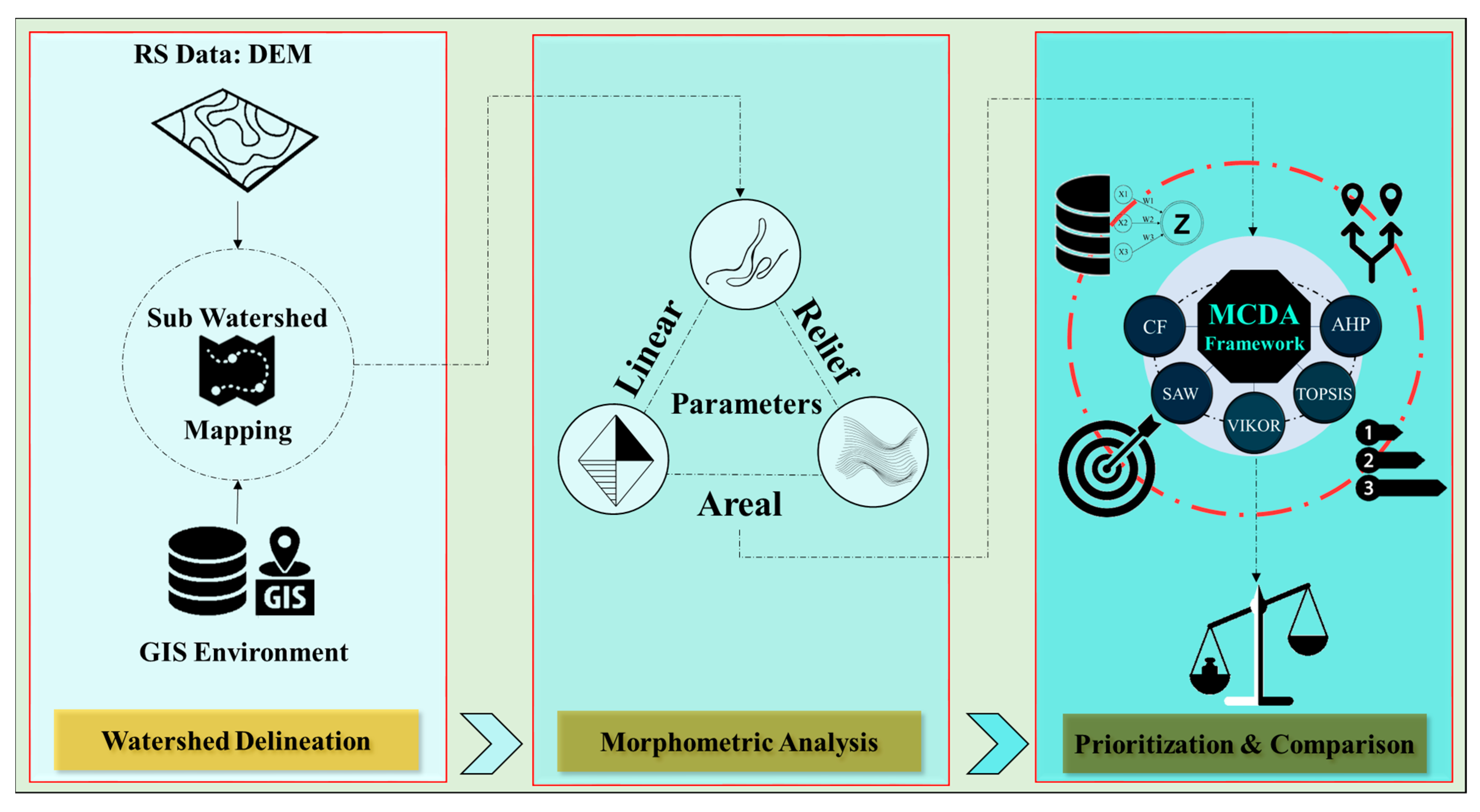

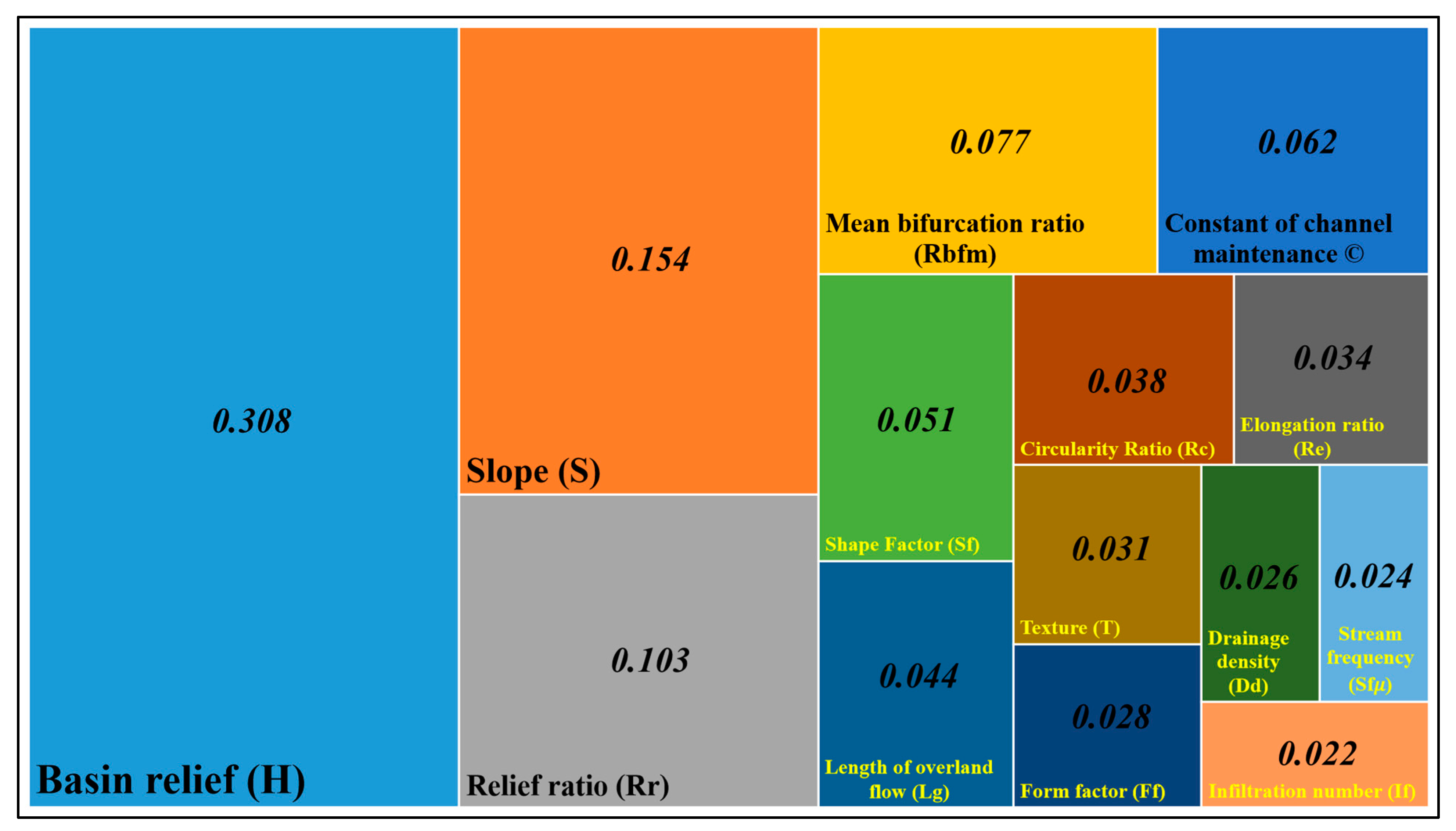
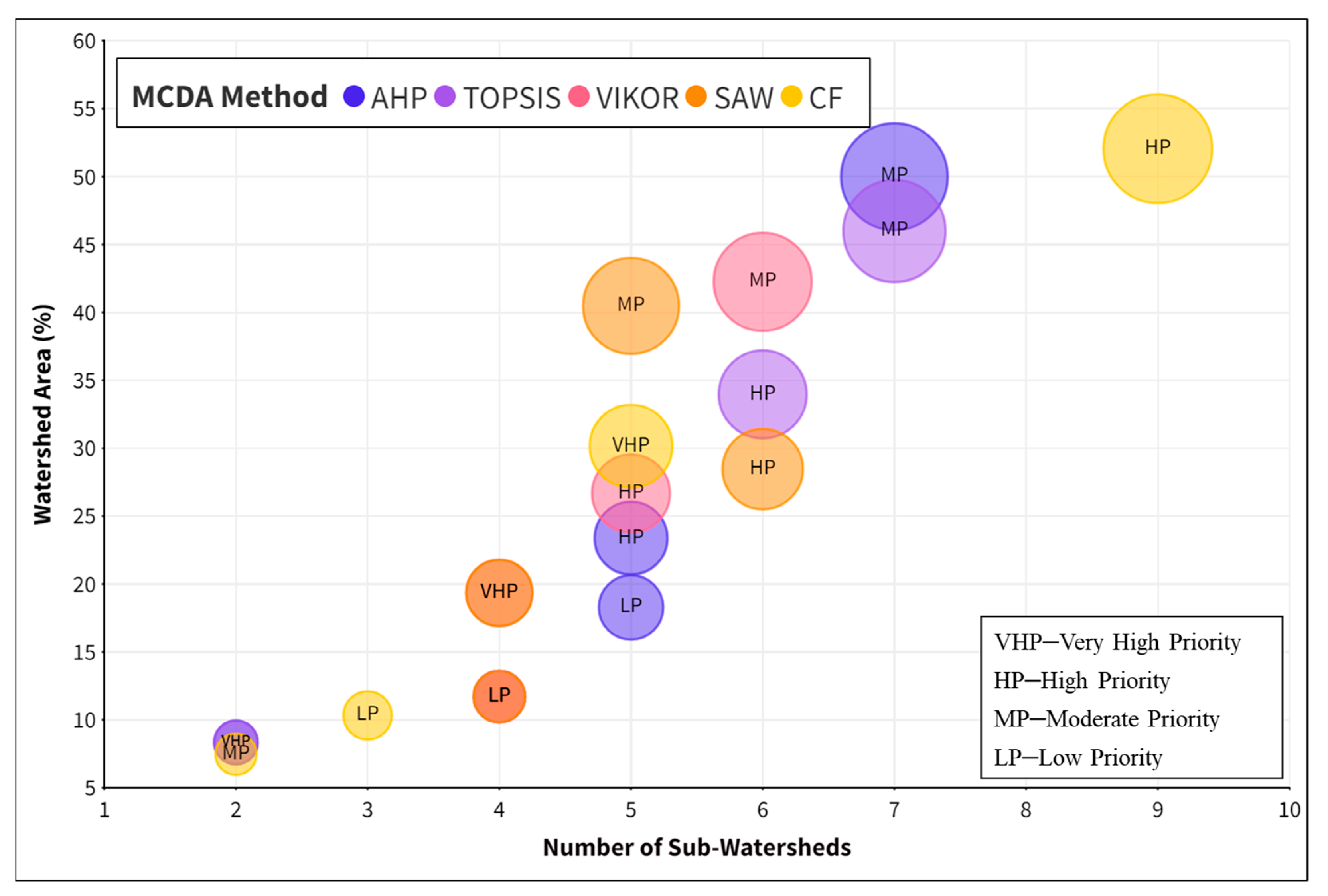
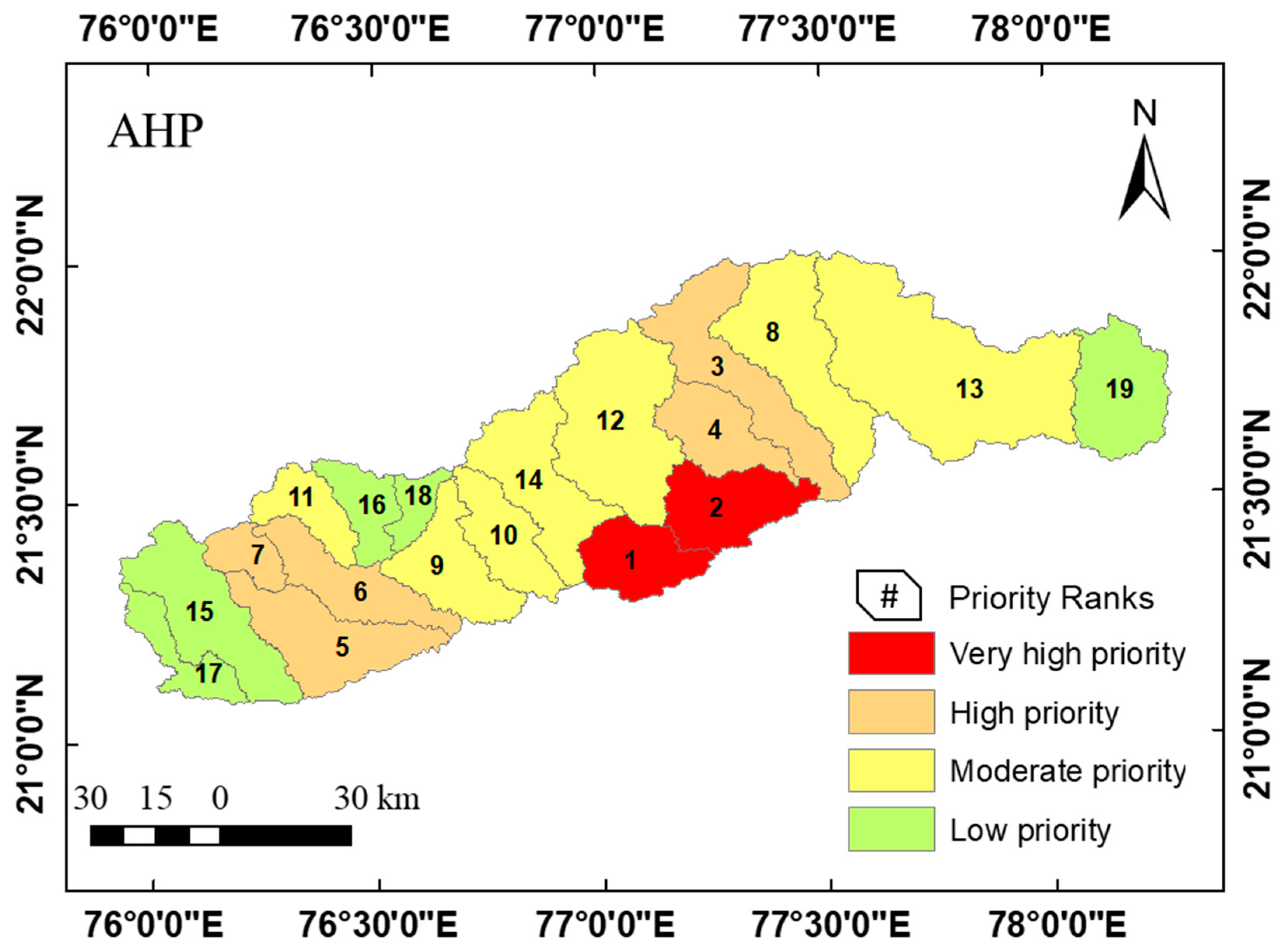
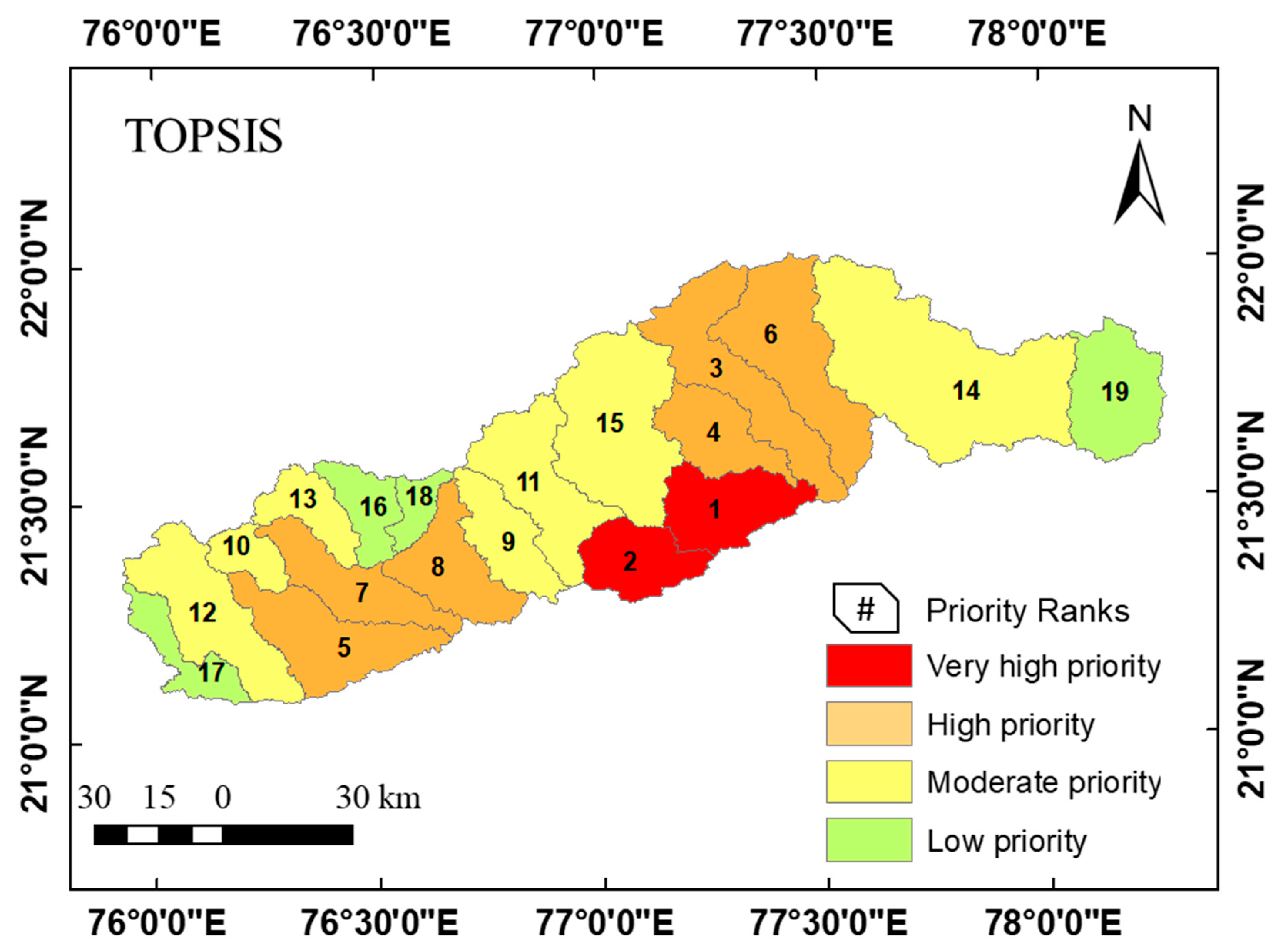
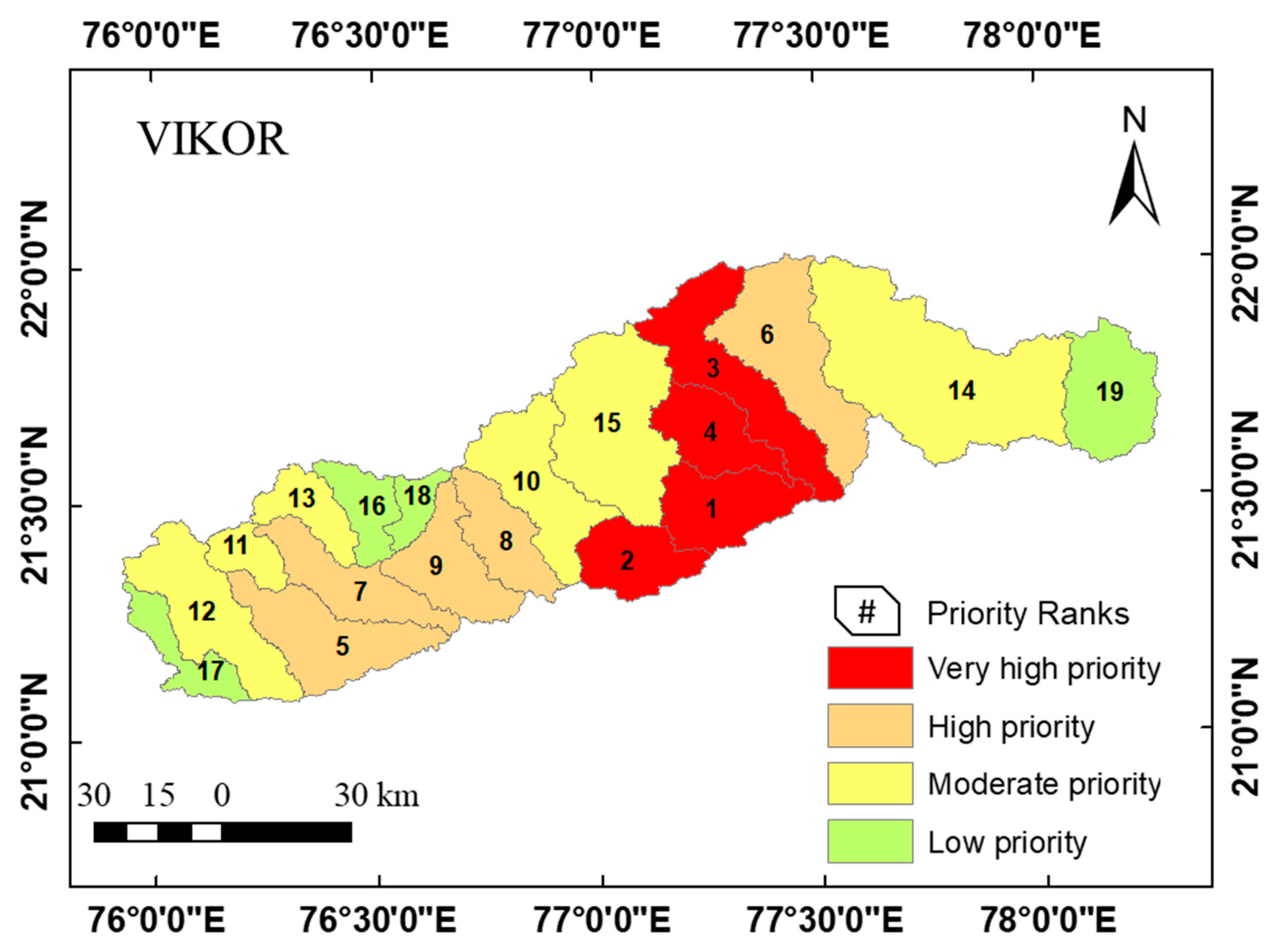
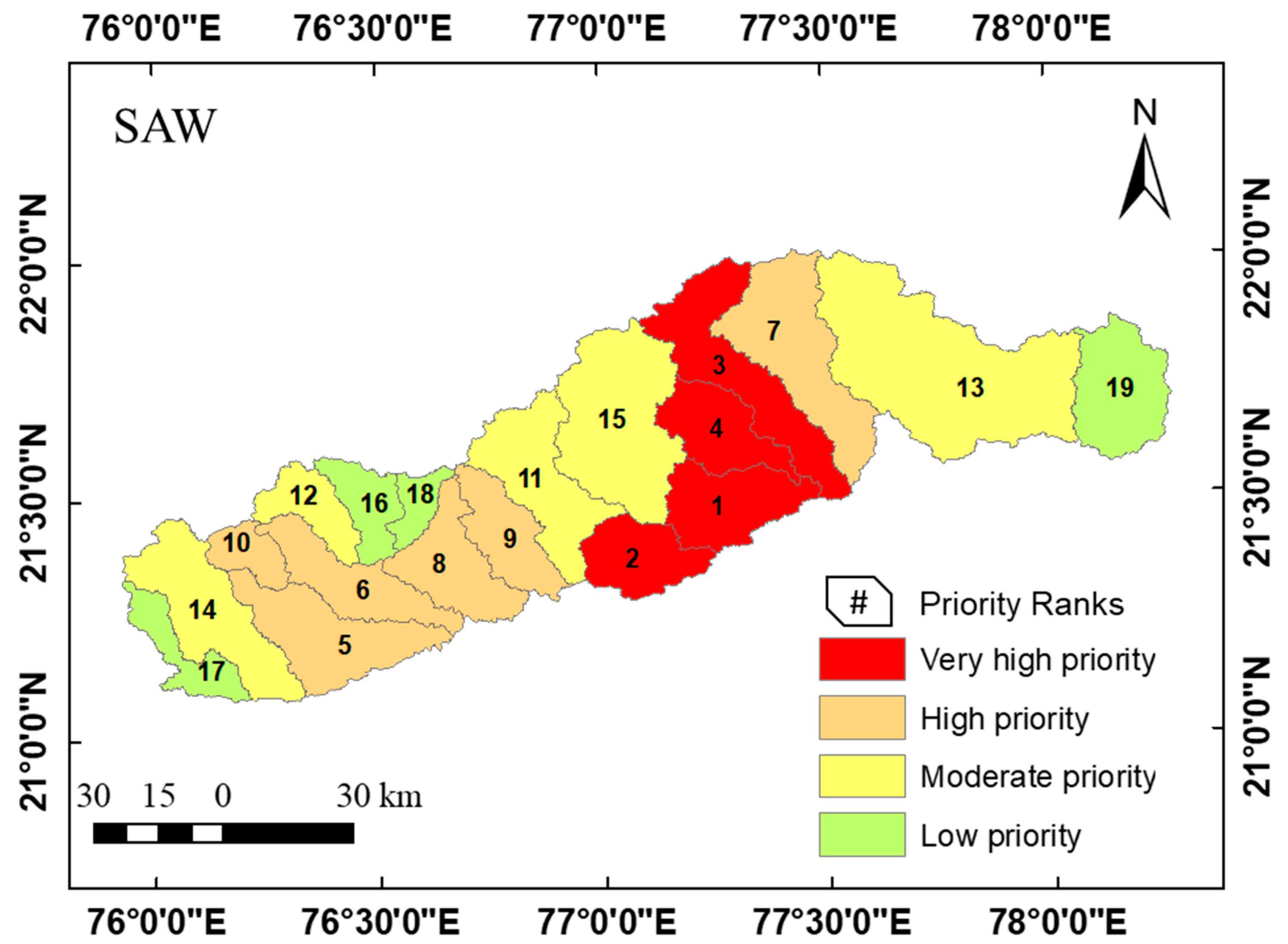


| Parameters | Quantification | Relation with Erosion Sensitivity | References |
|---|---|---|---|
| Mean bifurcation ratio (Rbfm) | Mean of Rb | DP | [57] |
| Drainage density (Dd) | Dd = ΣLu/A | DP | [58] |
| Stream frequency (Sfµ) | Fs = ΣNu/A | DP | [58] |
| Form factor (Ff) | Ff = A/Lb2 | IP | [58,59] |
| Shape factor (Fs) | Fs = Lb2/A | IP | [59] |
| Circulatory ratio (Rc) | Rc = 4πA/P2 | IP | [18,60] |
| Elongation ratio (Re) | Re = 1.128√A/Lb | IP | [57] |
| Constant of channel maintenance (C) | C = 1/Dd | DP | [57] |
| Infiltration number (If) | If = D × Fs | IP | [61] |
| Length of overland flow (Lg) | Lg = 1/2Dd | DP | [58] |
| Texture ratio (T) | T = ΣNu/P | DP | [62] |
| Basin relief (H) | H = Hmax − Hmin | DP | [63] |
| Relief ratio (Rr) | Rr = H/L | DP | [57] |
| Slope (S) | Mean of slope | DP | [23] |
| SW | H | S | Rr | Rbfm | C | Sf | Lg | Rc | Re | T | Ff | Dd | Sfµ | If |
|---|---|---|---|---|---|---|---|---|---|---|---|---|---|---|
| 1 | 429 | 9.37 | 4.83 | 4.67 | 4.94 | 4.72 | 2.47 | 0.28 | 0.52 | 0.16 | 0.21 | 0.20 | 0.03 | 0.005 |
| 2 | 812 | 14.02 | 14.40 | 2.31 | 4.83 | 4.24 | 2.42 | 0.15 | 0.55 | 0.07 | 0.24 | 0.21 | 0.02 | 0.005 |
| 3 | 418 | 10.93 | 6.31 | 3.94 | 5.41 | 4.40 | 2.71 | 0.33 | 0.54 | 0.13 | 0.23 | 0.18 | 0.03 | 0.005 |
| 4 | 548 | 9.28 | 10.60 | 1.61 | 5.43 | 4.15 | 2.71 | 0.23 | 0.55 | 0.09 | 0.24 | 0.18 | 0.03 | 0.005 |
| 5 | 383 | 6.69 | 12.27 | 1.67 | 5.43 | 3.68 | 2.72 | 0.16 | 0.59 | 0.08 | 0.27 | 0.18 | 0.04 | 0.008 |
| 6 | 592 | 10.54 | 15.13 | 2.00 | 4.53 | 3.88 | 2.27 | 0.26 | 0.57 | 0.09 | 0.26 | 0.22 | 0.03 | 0.007 |
| 7 | 593 | 12.39 | 13.54 | 2.50 | 5.93 | 3.99 | 2.96 | 0.26 | 0.56 | 0.07 | 0.25 | 0.17 | 0.02 | 0.004 |
| 8 | 278 | 5.98 | 12.50 | 3.00 | 4.13 | 3.39 | 2.07 | 0.29 | 0.61 | 0.09 | 0.29 | 0.24 | 0.05 | 0.012 |
| 9 | 382 | 8.39 | 12.21 | 2.00 | 4.79 | 3.68 | 2.40 | 0.31 | 0.59 | 0.09 | 0.27 | 0.21 | 0.03 | 0.007 |
| 10 | 453 | 8.81 | 14.12 | 2.50 | 4.35 | 3.70 | 2.17 | 0.30 | 0.59 | 0.10 | 0.27 | 0.23 | 0.04 | 0.009 |
| 11 | 655 | 9.86 | 15.08 | 3.00 | 4.93 | 3.98 | 2.46 | 0.21 | 0.57 | 0.08 | 0.25 | 0.20 | 0.03 | 0.006 |
| 12 | 485 | 11.33 | 18.85 | 3.00 | 4.97 | 3.51 | 2.48 | 0.38 | 0.60 | 0.09 | 0.28 | 0.20 | 0.04 | 0.007 |
| 13 | 716 | 12.40 | 13.82 | 1.33 | 4.34 | 4.15 | 2.17 | 0.24 | 0.55 | 0.09 | 0.24 | 0.23 | 0.03 | 0.006 |
| 14 | 493 | 9.23 | 9.12 | 1.80 | 4.04 | 4.19 | 2.02 | 0.24 | 0.55 | 0.10 | 0.24 | 0.25 | 0.03 | 0.007 |
| 15 | 814 | 22.59 | 20.93 | 2.33 | 5.09 | 3.88 | 2.54 | 0.46 | 0.57 | 0.09 | 0.26 | 0.20 | 0.02 | 0.005 |
| 16 | 780 | 22.42 | 17.58 | 3.67 | 4.88 | 4.00 | 2.44 | 0.35 | 0.56 | 0.11 | 0.25 | 0.20 | 0.03 | 0.006 |
| 17 | 741 | 13.83 | 18.40 | 2.00 | 4.20 | 3.91 | 2.10 | 0.27 | 0.57 | 0.07 | 0.26 | 0.24 | 0.02 | 0.005 |
| 18 | 654 | 13.60 | 10.97 | 2.25 | 4.01 | 4.29 | 2.01 | 0.23 | 0.54 | 0.09 | 0.23 | 0.25 | 0.02 | 0.006 |
| 19 | 290 | 4.90 | 6.06 | 2.33 | 5.76 | 4.07 | 2.88 | 0.41 | 0.56 | 0.07 | 0.25 | 0.17 | 0.02 | 0.003 |
| SD | 171.1 | 4.67 | 4.39 | 0.85 | 0.58 | 0.32 | 0.29 | 0.08 | 0.02 | 0.02 | 0.02 | 0.02 | 0.01 | 0.002 |
| Mean | 553.5 | 11.40 | 12.99 | 2.52 | 4.84 | 3.99 | 2.42 | 0.28 | 0.57 | 0.09 | 0.25 | 0.21 | 0.03 | 0.006 |
| Min | 278 | 4.90 | 4.83 | 1.33 | 4.01 | 3.39 | 2.01 | 0.15 | 0.52 | 0.07 | 0.21 | 0.17 | 0.02 | 0.003 |
| Max | 814 | 22.59 | 20.93 | 4.67 | 5.93 | 4.72 | 2.96 | 0.46 | 0.61 | 0.16 | 0.29 | 0.25 | 0.05 | 0.012 |
| Range | 536.0 | 17.70 | 16.10 | 3.34 | 1.91 | 1.33 | 0.96 | 0.30 | 0.09 | 0.09 | 0.08 | 0.08 | 0.03 | 0.009 |
| No. | Parameter | Relation with Erosion Sensitivity | Min (SW ID) | Max (SW ID) | WS with Erosion Sensitivity | |
|---|---|---|---|---|---|---|
| Lowest | Highest | |||||
| 1 | Basin relief (H) | DP | 278 (8) | 814 (15) | 8 | 15 |
| 2 | Slope (S) | DP | 4.90 (19) | 22.59 (15) | 19 | 15 |
| 3 | Relief ratio (Rr) | DP | 4.83 (1) | 20.93 (15) | 1 | 15 |
| 4 | Mean bifurcation ratio (Rbfm) | DP | 1.33 (13) | 4.67 (1) | 13 | 1 |
| 5 | Constant of channel maintenance (C) | DP | 4.01 (18) | 5.93 (7) | 18 | 7 |
| 6 | Shape Factor (Sf) | IP | 3.39 (8) | 4.72 (1) | 1 | 8 |
| 7 | Length of overland flow (Lg) | DP | 2.01 (18) | 2.96 (7) | 18 | 7 |
| 8 | Circularity Ratio (Rc) | IP | 0.15 (2) | 0.46 (15) | 15 | 2 |
| 9 | Elongation ratio (Re) | IP | 0.52 (1) | 0.61 (8) | 8 | 1 |
| 10 | Texture (T) | DP | 0.07 (17) | 0.16 (1) | 17 | 1 |
| 11 | Form factor (Ff) | IP | 0.21 (1) | 0.29 (8) | 8 | 1 |
| 12 | Drainage density (Dd) | DP | 0.17 (7) | 0.25 (18) | 7 | 18 |
| 13 | Stream frequency (Sfµ) | DP | 0.02 (19) | 0.05 (8) | 19 | 8 |
| 14 | Infiltration number (If) | IP | 0.003 (19) | 0.012 (8) | 8 | 19 |
| H | S | Rr | Rbfm | C | Sf | Lg | Rc | Re | T | Ff | Dd | Sfµ | If | |
|---|---|---|---|---|---|---|---|---|---|---|---|---|---|---|
| H | 1 | 2 | 3 | 4 | 5 | 6 | 7 | 8 | 9 | 10 | 11 | 12 | 13 | 14 |
| S | 0.50 | 1 | 1.5 | 2 | 2.5 | 3 | 3.5 | 4 | 4.5 | 5 | 5.5 | 6 | 6.5 | 7 |
| Rr | 0.33 | 0.67 | 1 | 1.33 | 1.67 | 2 | 2.33 | 2.67 | 3 | 3.33 | 3.67 | 4 | 4.33 | 4.67 |
| Rbfm | 0.25 | 0.50 | 0.75 | 1 | 1.25 | 1.5 | 1.75 | 2 | 2.25 | 2.5 | 2.75 | 3 | 3.25 | 3.5 |
| C | 0.20 | 0.40 | 0.60 | 0.80 | 1 | 1.2 | 1.4 | 1.6 | 1.8 | 2 | 2.2 | 2.4 | 2.6 | 2.8 |
| Sf | 0.17 | 0.33 | 0.50 | 0.67 | 0.83 | 1 | 1.17 | 1.33 | 1.5 | 1.67 | 1.83 | 2 | 2.17 | 2.33 |
| Lg | 0.14 | 0.29 | 0.43 | 0.57 | 0.71 | 0.86 | 1 | 1.14 | 1.29 | 1.43 | 1.57 | 1.71 | 1.86 | 2 |
| Rc | 0.13 | 0.25 | 0.38 | 0.50 | 0.63 | 0.75 | 0.88 | 1 | 1.125 | 1.25 | 1.375 | 1.5 | 1.625 | 1.75 |
| Re | 0.11 | 0.22 | 0.33 | 0.44 | 0.56 | 0.67 | 0.78 | 0.89 | 1 | 1.11 | 1.22 | 1.33 | 1.44 | 1.56 |
| T | 0.10 | 0.20 | 0.30 | 0.40 | 0.50 | 0.60 | 0.70 | 0.80 | 0.90 | 1 | 1.1 | 1.2 | 1.3 | 1.4 |
| Ff | 0.09 | 0.18 | 0.27 | 0.36 | 0.45 | 0.55 | 0.64 | 0.73 | 0.82 | 0.91 | 1 | 1.09 | 1.18 | 1.27 |
| Dd | 0.08 | 0.17 | 0.25 | 0.33 | 0.42 | 0.50 | 0.58 | 0.67 | 0.75 | 0.83 | 0.92 | 1 | 1.08 | 1.17 |
| Sfµ | 0.08 | 0.15 | 0.23 | 0.31 | 0.38 | 0.46 | 0.54 | 0.62 | 0.69 | 0.77 | 0.85 | 0.92 | 1 | 1.08 |
| If | 0.07 | 0.14 | 0.21 | 0.29 | 0.36 | 0.43 | 0.50 | 0.57 | 0.64 | 0.71 | 0.79 | 0.86 | 0.93 | 1 |
| AHP | TOPSIS | VIKOR | SAW | CF | ||||||
|---|---|---|---|---|---|---|---|---|---|---|
| SW | Rank | Class | Rank | Class | Rank | Class | Rank | Class | Rank | Class |
| 1 | 13 | MP | 14 | MP | 14 | MP | 13 | MP | 7 | HP |
| 2 | 3 | HP | 3 | HP | 3 | VHP | 3 | VHP | 2 | VHP |
| 3 | 12 | MP | 15 | MP | 15 | MP | 15 | MP | 9 | HP |
| 4 | 14 | MP | 11 | MP | 10 | MP | 11 | MP | 15 | MP |
| 5 | 17 | LP | 17 | LP | 17 | LP | 17 | LP | 18 | LP |
| 6 | 10 | MP | 9 | MP | 8 | HP | 9 | HP | 8 | HP |
| 7 | 9 | MP | 8 | HP | 9 | HP | 8 | HP | 13 | HP |
| 8 | 18 | LP | 18 | LP | 18 | LP | 18 | LP | 16 | MP |
| 9 | 16 | LP | 16 | LP | 16 | LP | 16 | LP | 17 | LP |
| 10 | 11 | MP | 13 | MP | 13 | MP | 12 | MP | 12 | HP |
| 11 | 6 | HP | 7 | HP | 7 | HP | 6 | HP | 4 | VHP |
| 12 | 7 | HP | 10 | MP | 11 | MP | 10 | HP | 14 | HP |
| 13 | 5 | HP | 5 | HP | 5 | HP | 5 | HP | 5 | VHP |
| 14 | 15 | LP | 12 | MP | 12 | MP | 14 | MP | 11 | HP |
| 15 | 1 | VHP | 2 | VHP | 2 | VHP | 2 | VHP | 6 | HP |
| 16 | 2 | VHP | 1 | VHP | 1 | VHP | 1 | VHP | 1 | VHP |
| 17 | 4 | HP | 4 | HP | 4 | VHP | 4 | VHP | 9 | HP |
| 18 | 8 | MP | 6 | HP | 6 | HP | 7 | HP | 3 | VHP |
| 19 | 19 | LP | 19 | LP | 19 | LP | 19 | LP | 19 | LP |
| Percentage Change | Change of Intensity | |||||||||
|---|---|---|---|---|---|---|---|---|---|---|
| AHP | TOPSIS | VIKOR | SAW | CF | AHP | TOPSIS | VIKOR | SAW | CF | |
| AHP | 0 | 63.16 | 57.89 | 52.63 | 89.47 | 1 | 1.038 | 1.042 | 1.034 | 1.165 |
| TOPSIS | 63.16 | 0 | 21.05 | 26.32 | 84.21 | 1.038 | 1 | 1.001 | 1.002 | 1.109 |
| VIKOR | 57.89 | 21.05 | 0 | 47.37 | 78.95 | 1.042 | 1.001 | 1 | 1.003 | 1.107 |
| SAW | 52.63 | 26.32 | 47.37 | 0 | 78.95 | 1.034 | 1.002 | 1.003 | 1 | 1.111 |
| CF | 89.47 | 84.21 | 78.95 | 78.95 | 0 | 1.165 | 1.109 | 1.107 | 1.111 | 1 |
| Average | 52.63 | 38.95 | 41.05 | 41.05 | 66.32 | 1.055 | 1.030 | 1.030 | 1.030 | 1.098 |
Disclaimer/Publisher’s Note: The statements, opinions and data contained in all publications are solely those of the individual author(s) and contributor(s) and not of MDPI and/or the editor(s). MDPI and/or the editor(s) disclaim responsibility for any injury to people or property resulting from any ideas, methods, instructions or products referred to in the content. |
© 2023 by the authors. Licensee MDPI, Basel, Switzerland. This article is an open access article distributed under the terms and conditions of the Creative Commons Attribution (CC BY) license (https://creativecommons.org/licenses/by/4.0/).
Share and Cite
Patel, A.; Ramana Rao, K.V.; Rajwade, Y.A.; Saxena, C.K.; Singh, K.; Srivastava, A. Comparative Analysis of MCDA Techniques for Identifying Erosion-Prone Areas in the Burhanpur Watershed in Central India for the Purposes of Sustainable Watershed Management. Water 2023, 15, 3891. https://doi.org/10.3390/w15223891
Patel A, Ramana Rao KV, Rajwade YA, Saxena CK, Singh K, Srivastava A. Comparative Analysis of MCDA Techniques for Identifying Erosion-Prone Areas in the Burhanpur Watershed in Central India for the Purposes of Sustainable Watershed Management. Water. 2023; 15(22):3891. https://doi.org/10.3390/w15223891
Chicago/Turabian StylePatel, Abhishek, K. V. Ramana Rao, Yogesh A. Rajwade, Chandra Kant Saxena, Karan Singh, and Ankur Srivastava. 2023. "Comparative Analysis of MCDA Techniques for Identifying Erosion-Prone Areas in the Burhanpur Watershed in Central India for the Purposes of Sustainable Watershed Management" Water 15, no. 22: 3891. https://doi.org/10.3390/w15223891
APA StylePatel, A., Ramana Rao, K. V., Rajwade, Y. A., Saxena, C. K., Singh, K., & Srivastava, A. (2023). Comparative Analysis of MCDA Techniques for Identifying Erosion-Prone Areas in the Burhanpur Watershed in Central India for the Purposes of Sustainable Watershed Management. Water, 15(22), 3891. https://doi.org/10.3390/w15223891







